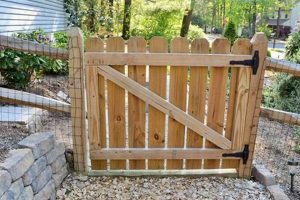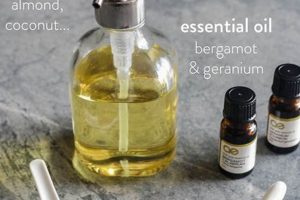The ability to refresh the visual appeal of bedroom furniture through self-initiated projects involving fabric and padding offers an avenue for personalization. This method specifically addresses the upholstered component positioned at the head of a bed, allowing for modifications without the need for complete replacement. An example would be using a staple gun and chosen textile to modify an existing wooden headboard frame.
Such endeavors provide opportunities for cost savings compared to purchasing new furniture and align with principles of sustainable consumption by extending the lifespan of existing items. Throughout interior design history, the headboard has evolved from a practical insulator to a decorative focal point, and the ability to alter its appearance contributes to its continued relevance in contemporary bedroom aesthetics. The act of personalizing these features has been around for decades, and even longer if you consider the construction of headboards by the owner as a means of practicality rather than cost savings.
The subsequent sections will detail various methodologies for achieving a refreshed headboard appearance, encompassing materials, tools, and step-by-step instructions suitable for a range of skill levels. Specific considerations for different headboard shapes and sizes will be addressed, alongside potential design considerations.
Refurbishing Headboards
Modifying the appearance of a headboard through fabric and padding requires careful planning and execution. The following tips aim to ensure a successful and aesthetically pleasing outcome.
Tip 1: Material Selection is Paramount: Prioritize durable fabrics suited for upholstery. Consider factors such as stain resistance, weave density, and colorfastness. Linen, cotton blends, and synthetic microfibers are common choices. Samples should be tested for wear and tear before committing to a large purchase.
Tip 2: Precise Measurement Prevents Errors: Accurate dimensions of the headboard are critical. Measure both the front and any sides to be covered, adding extra material for seam allowances and wrapping around edges. Double-checking measurements reduces the risk of insufficient fabric.
Tip 3: Padding Enhances Comfort and Appearance: A layer of batting or foam padding beneath the fabric contributes to a softer, more luxurious feel. Different densities of foam offer varying degrees of support. Ensure the padding is evenly distributed to avoid lumps or uneven surfaces.
Tip 4: Secure Attachment is Essential: A heavy-duty staple gun with appropriately sized staples is necessary for attaching the fabric securely to the headboard frame. Staples should be evenly spaced and driven straight to prevent tearing or loosening. Consider using a staple remover for corrections.
Tip 5: Smooth Fabric Application Creates a Professional Finish: When applying the fabric, pull it taut and smooth out any wrinkles or bubbles. Work from the center outwards, securing the fabric incrementally. Using a fabric-smoothing tool can aid in achieving a flawless surface.
Tip 6: Attention to Detail Elevates the Final Result: Pay close attention to corners and edges, ensuring clean folds and secure attachments. Mitering corners provides a professional finish. Consider adding decorative elements such as nailhead trim or piping for added visual interest.
Tip 7: Frame Preparation Is Key: Inspect the headboard frame for any damage or imperfections. Repair cracks or loose joints before commencing with the project. Sanding rough surfaces ensures a smooth and even foundation for the new fabric and padding.
The successful refurbishment of a headboard hinges on meticulous preparation, careful material selection, and precise execution. Following these guidelines enhances both the aesthetic appeal and the longevity of the finished product.
The concluding sections will explore design inspiration and advanced techniques for creating customized headboard coverings.
1. Fabric Selection
Fabric selection is a paramount component of the “diy cover headboard” process, directly influencing the finished product’s aesthetic appeal, durability, and ease of maintenance. The chosen textile dictates the visual style of the headboard, contributing to the overall bedroom ambiance. For example, a velvet fabric may evoke a sense of luxury, while a linen fabric suggests a more casual and relaxed atmosphere. The type of fabric also affects its resistance to wear and tear; a tightly woven fabric will generally withstand more abrasion than a loosely woven one. This influences the lifespan of the finished cover.
The practical implications of fabric selection extend to cleaning and maintenance. Certain fabrics are more prone to staining than others, while some may require professional cleaning. Opting for a stain-resistant fabric or one that is easily washable can significantly reduce upkeep efforts. Real-life examples include choosing a microfiber fabric for households with children or pets due to its durability and ease of cleaning, or selecting a tightly woven cotton for a crisp, tailored look that can withstand daily wear. The selected material also has practical implications for the construction process; thicker fabrics require more robust tools and techniques for secure attachment to the headboard frame.
In summary, the selection of fabric is a critical decision point in any headboard modification project, and contributes to the visual impact of the room. It’s not simply about aesthetic preference but also about balancing style with practicality and longevity. Challenges in this decision include balancing cost with quality and finding a fabric that complements the existing bedroom decor while meeting the demands of daily use. Considering the long-term implications of fabric choice ensures a satisfying and enduring result.
2. Padding density
The density of padding utilized in a “diy cover headboard” project exerts a substantial influence on both the aesthetic and functional qualities of the finished piece. Higher density padding provides a firmer surface, resulting in a more structured appearance and increased resistance to compression over time. Conversely, lower density padding yields a softer, more yielding surface, potentially sacrificing long-term shape retention for enhanced initial comfort. The choice of density, therefore, presents a critical trade-off between visual structure and tactile experience.
The practical implications of padding density extend to the cover’s lifespan and the overall support provided. A headboard designed for reading or sitting upright may benefit from higher density padding, ensuring adequate back support and preventing premature sagging of the fabric. In contrast, a headboard primarily intended for decorative purposes may prioritize lower density padding for a plusher, more inviting feel. Real-world examples include utilizing high-density foam for a mini
malist, modern headboard designed to maintain clean lines over extended use, or employing a combination of high and low-density padding to achieve both support and a luxurious surface feel. The selection process must also consider the thickness of the padding, as this complements density in determining the final firmness and visual profile.
In summary, the appropriate selection of padding density for a “diy cover headboard” is a crucial determinant of its long-term performance and aesthetic suitability. The challenges lie in accurately assessing the intended use, balancing the desire for visual structure with comfort considerations, and selecting materials that offer an optimal compromise between these competing factors. Careful consideration of these aspects ensures a finished product that is both visually appealing and functionally appropriate for its intended purpose.
3. Frame integrity
Frame integrity constitutes a foundational element for any “diy cover headboard” project. The structural soundness of the underlying frame directly influences the longevity, stability, and aesthetic outcome of the finished piece. A compromised frame, characterized by weaknesses such as loose joints, cracks, or warping, invariably leads to an unstable and visually unsatisfactory final product. The application of fabric and padding, while intended to enhance appearance, cannot compensate for pre-existing structural deficiencies. A weak frame will continue to degrade, ultimately causing the covering to sag, tear, or detach prematurely. Consider the situation where an attempt is made to re-cover a headboard with a frame suffering from wood rot. The new fabric, regardless of its quality, will likely tear away as the rotting wood crumbles under the stress of stapling, rendering the entire project futile.
Addressing frame integrity prior to commencing the covering process is, therefore, a critical preventative measure. This often entails reinforcing joints with wood glue and screws, repairing cracks with wood filler, and, in severe cases, replacing damaged sections entirely. Neglecting this preliminary step carries significant practical consequences, as the cost of materials and labor invested in the covering can be rendered worthless by the subsequent failure of the underlying frame. Conversely, a thoroughly inspected and repaired frame provides a stable and durable foundation, ensuring the “diy cover headboard” project yields a lasting and aesthetically pleasing result. This attention to structural detail distinguishes a professional-quality refurbishment from a merely superficial one. For instance, a metal frame with rusted joints would necessitate thorough rust removal, treatment with a rust inhibitor, and reinforcement of the welds before any covering material is applied. The same principle applies to wooden frames that require proper sanding and sealing to ensure optimal adhesion.
In summary, the success of a “diy cover headboard” is inextricably linked to the integrity of its frame. Addressing structural weaknesses beforehand is not merely a precautionary measure but an essential investment that safeguards the overall project’s value and longevity. Challenges in ensuring frame integrity include accurate diagnosis of existing damage, selection of appropriate repair techniques, and proper execution of those techniques. Prioritizing this fundamental aspect ensures a durable, aesthetically pleasing headboard covering that will withstand the test of time.
4. Measurement accuracy
Measurement accuracy is a critical determinant of success in any “diy cover headboard” undertaking. Inaccurate measurements can lead to material wastage, fitting issues, and a compromised aesthetic outcome, undermining the entire project’s value.
- Fabric Quantity Determination
Precise measurements dictate the exact amount of fabric required to cover the headboard. Undermeasuring results in insufficient material, necessitating additional purchases or compromising the design. Overmeasuring, while less problematic, leads to unnecessary expense and material waste. For example, a discrepancy of even a few inches can result in a significant shortage when attempting to cover a large, curved headboard, requiring a costly and potentially color-mismatched fabric reorder. Accurate measurement is vital for economical material acquisition.
- Padding Material Calculation
Similar to fabric, accurate dimensions are essential for determining the appropriate amount of padding material. Insufficient padding can lead to an uneven surface and a lack of desired comfort, while excessive padding can create a bulky, ill-fitting cover. Precise measurements enable the proper layering and distribution of padding, ensuring a smooth, consistent surface and optimal support. An example includes the need to precisely measure the headboard’s thickness to determine the amount of batting needed to achieve a specific level of plushness without distorting the overall shape.
- Pattern Alignment and Seam Placement
When using patterned fabrics, accurate measurements are crucial for ensuring proper pattern alignment across the headboard cover. Misaligned patterns can detract significantly from the finished product’s aesthetic appeal. Furthermore, precise measurements are necessary for strategically placing seams in inconspicuous locations, minimizing their visual impact. In a scenario involving a large-scale floral pattern, inaccurate measurements can result in a jarring, asymmetrical appearance, while precise measurements allow for seamless pattern continuation across multiple panels.
- Frame Fit and Edge Wrapping
Accurate measurements are fundamental for ensuring the finished cover fits snugly and securely around the headboard frame. Imprecise dimensions can result in a loose, ill-fitting cover that sags or wrinkles, detracting from the overall appearance. Precise measurements also enable proper edge wrapping, ensuring the fabric is securely fastened to the back of the frame without excess bulk or unsightly gaps. A tight, well-fitted cover not only enhances the aesthetic appeal but also contributes to the durability and longevity of the finished product. For instance, with a complexly shaped headboard, inaccurate measurements could cause fabric pulling at the corners, eventually leading to tears.
The above facets highlight the fundamental importance of measurement accuracy in successfully executing a “diy cover headboard.” Accurate measurements are not merely a procedural step but a critical determinant of the project’s efficiency, cost-effectiveness, and ultimately, its aesthetic and functional success. The implementation of careful measurement techniques significantly reduces the risk of errors, minimizes material waste, and ensures a professional-quality finished product.
5. Attachment security
Attachment security is a non-negotiable prerequisite for any durable and aesthetically pleasing “diy cover headboard.” It refers to the reliable and lasting fastening of the chosen fabric and padding to the underlying headboard frame. The absence of secure attachment precipitates a cascade of negative consequences, ranging from premature wear and tear to compl
ete project failure. If the fabric is not firmly affixed, it will inevitably shift, sag, and ultimately detach from the frame, rendering the headboard aesthetically unappealing and functionally compromised. A real-life example is the use of insufficient staples or an inadequate adhesive. The fabric could detach within a short timeframe, thereby diminishing the project and leading to premature replacement or repair. Attachment is more than just the literal bond of materials; its a pillar of long-term enjoyment.
Several factors influence the effectiveness of attachment security. The choice of attachment method (staples, adhesive, tacks), the quality of materials utilized (staple gauge, adhesive strength), and the skill of the person performing the attachment (staple spacing, adhesive application) all play critical roles. Furthermore, the nature of the headboard frame itself (wood density, material composition) can significantly impact the ease and reliability of attachment. Practical application dictates the use of a heavy-duty staple gun with correctly sized staples for wooden frames, while a specialized adhesive may be necessary for metal or plastic frames. Proper tensioning of the fabric during attachment is crucial to prevent sagging and ensure a smooth, even surface. The technique itself is important, meaning the proper tensioning of the fabric is important to prevent future degradation. The durability of the staple and the surface are also important for the future as well.
In summary, attachment security is the cornerstone of a successful and long-lasting “diy cover headboard.” Neglecting this critical aspect results in a compromised aesthetic, reduced durability, and potential project failure. The challenges involved in achieving optimal attachment security necessitate careful consideration of materials, methods, and techniques, ultimately ensuring a professional-quality finish that withstands the test of time. This consideration and adherence can be the difference between a headboard cover that lasts a few months or potentially years if the attachment is solid.
6. Design coherence
Design coherence, within the context of a “diy cover headboard” project, refers to the harmonious integration of the headboard’s aesthetic qualities with the existing or intended design scheme of the bedroom. The headboard, often serving as a focal point, significantly influences the overall ambiance of the space; therefore, its design must align with the room’s established style to create a unified and visually pleasing environment. A lack of design coherence introduces disharmony, disrupting the intended aesthetic and diminishing the room’s overall appeal. The selection of fabric, color palette, texture, and embellishments must, therefore, be carefully considered in relation to existing furniture, wall color, bedding, and accessories. A modern bedroom, for example, would clash with a headboard covered in ornate, floral-patterned fabric, while a rustic bedroom would be similarly discordant with a sleek, minimalist headboard design. Therefore, the cover should either integrate into the room, or the room itself must be designed around the headboard.
Achieving design coherence necessitates a thorough assessment of the bedroom’s existing design elements. This includes identifying the dominant style (e.g., contemporary, traditional, bohemian), understanding the prevailing color scheme, and recognizing the textures and patterns already present in the space. Based on this assessment, a headboard cover can be designed to either complement or subtly contrast with the existing elements. A complementary approach involves selecting fabrics and colors that harmonize with the room’s existing palette, while a contrasting approach might involve introducing a contrasting color or pattern to create visual interest. However, even in cases of intentional contrast, the design should maintain a sense of balance and avoid overwhelming the overall aesthetic. For instance, in a bedroom with predominantly neutral tones, a headboard covered in a bold, geometric-patterned fabric could serve as a striking focal point, provided the pattern’s colors are subtly echoed in other accessories throughout the room.
In summary, design coherence represents a crucial consideration in any “diy cover headboard” project. It is not merely about creating an aesthetically pleasing headboard cover in isolation, but about crafting a design that seamlessly integrates with and enhances the overall visual harmony of the bedroom. Challenges in achieving design coherence stem from the subjectivity of aesthetic preferences and the complexities of coordinating disparate design elements. However, a systematic approach, involving careful assessment of existing elements, thoughtful selection of materials, and a clear understanding of design principles, significantly increases the likelihood of a successful and aesthetically satisfying outcome.
Frequently Asked Questions
The following addresses common inquiries regarding the process of creating a self-made headboard covering.
Question 1: Is prior upholstery experience required to create a satisfactory headboard cover?
Formal upholstery training is not strictly necessary. However, familiarity with basic sewing techniques, fabric handling, and the safe operation of tools such as staple guns is highly recommended. Beginners may benefit from starting with simpler headboard shapes and gradually progressing to more complex designs.
Question 2: What are the essential tools for undertaking a headboard covering project?
Key tools include a heavy-duty staple gun, appropriately sized staples, fabric scissors, a measuring tape, a seam ripper (for removing existing fabric), and a mallet or rubber hammer (for securing decorative trim). A sewing machine may be required for more intricate designs or custom embellishments.
Question 3: How does one determine the appropriate amount of fabric required?
Accurate measurements of the headboard’s dimensions, including height, width, and thickness, are essential. Add extra fabric for seam allowances, edge wrapping, and pattern matching (if applicable). Consulting fabric calculators or seeking advice from fabric retailers can assist in accurate quantity estimation.
Question 4: What types of fabric are best suited for headboard coverings?
Durable, tightly woven fabrics such as linen, cotton blends, and upholstery-grade synthetics are generally recommended. Consider factors such as stain resistance, colorfastness, and abrasion resistance. Fabric samples should be tested for wear and tear before committing to a large purchase.
Question 5: How can wrinkles and sagging be prevented during the covering process?
Proper fabric tensioning is crucial. Pull the fabric taut and smooth out any wrinkles before securing it to the frame. Work from the center outwards, securing the fabric incrementally. Using a fabric-smoothing tool or steam iron can aid in achieving a flawless surface.
Question 6: What steps should be taken to ensure the long-term durability of a diy cover headboard?
Regular cleaning and maintenance are essential. Vacuum the fabric regularly to remove dust and debris. Address stains promptly using appropriate cleaning agents. Avoid exposing the headboard to direct sunlight or excessive moisture, which can cause fading and damage.
Careful planning and execution are crucial for the longevity of a headboard covering project.
The following section explores potential design options.
DIY Cover Headboard
The preceding discourse has illuminate
d the multifaceted nature of the “diy cover headboard” undertaking. From the critical selection of appropriate fabrics and padding densities to the imperative of ensuring structural integrity and precise measurements, the process demands meticulous attention to detail. The ultimate success hinges upon the harmonious integration of functional considerations and aesthetic aspirations, resulting in a personalized bedroom feature that both endures and enhances the overall design.
As individuals seek cost-effective and environmentally conscious methods of personalizing their living spaces, the principles outlined herein provide a foundation for informed decision-making. The knowledge imparted serves not only as a guide for current endeavors but also as a stimulus for future exploration, encouraging innovation in design and responsible consumption within the realm of interior decor. Embrace the opportunity to transform the headboard and, subsequently, the space around it.







